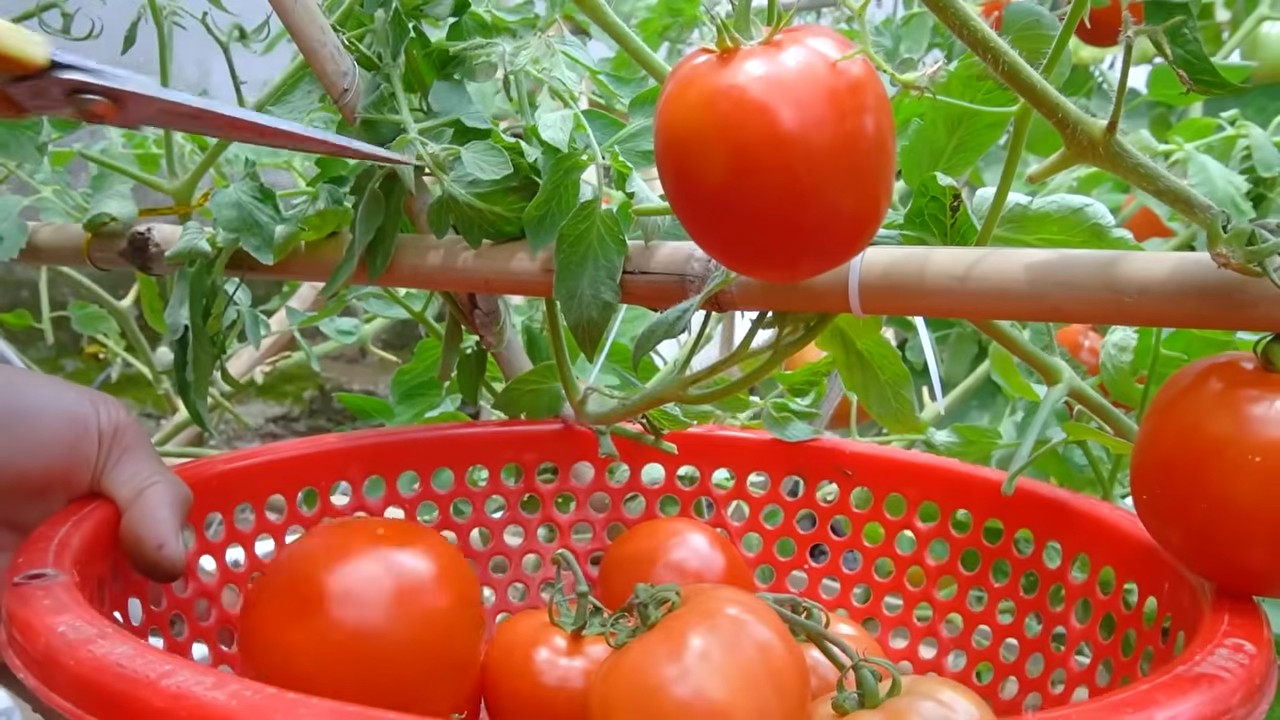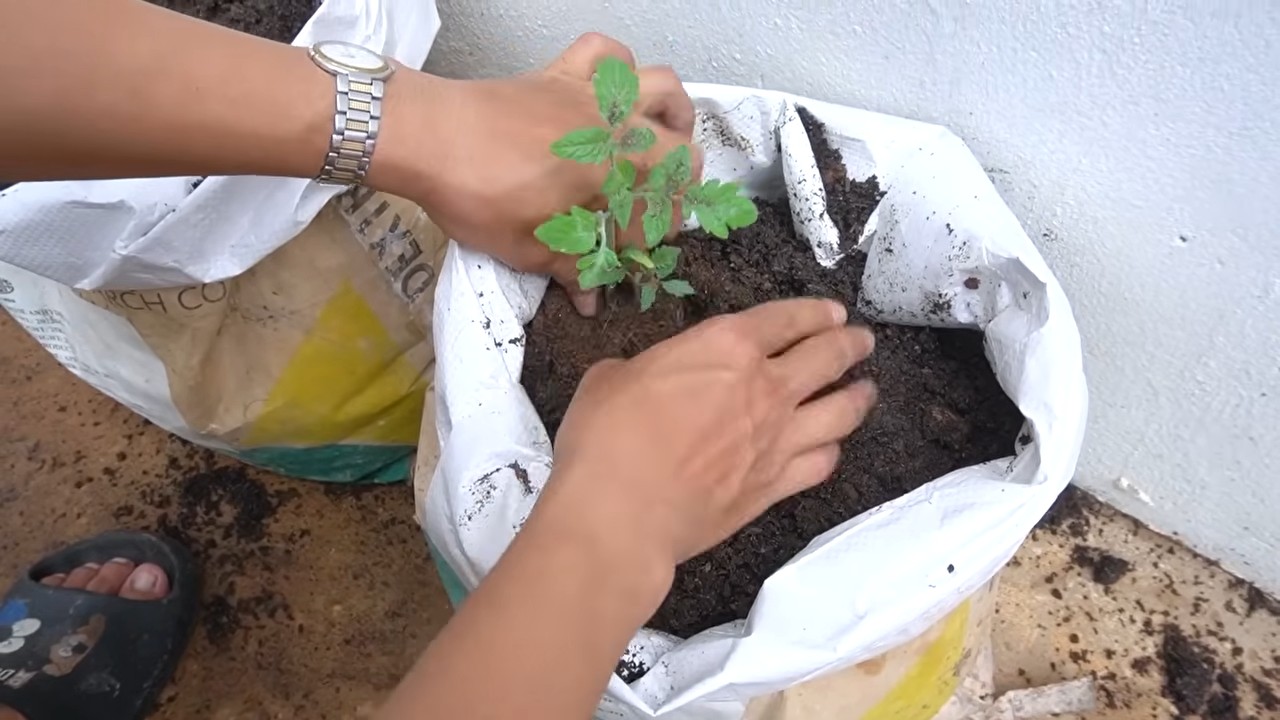Year Round Tomato Growing: Imagine biting into a juicy, sun-ripened tomato in the dead of winter. Sounds like a dream, right? Well, it doesn’t have to be! For centuries, humans have strived to extend the growing season, experimenting with techniques to coax warmth and light into the colder months. From ancient Roman greenhouses to modern-day hydroponics, the desire for fresh produce year-round is deeply ingrained in our history.
But let’s be honest, most of us don’t have the space or budget for a fancy greenhouse. That’s where these simple, yet effective, DIY tricks come in. I’m going to share some of my favorite hacks for year round tomato growing, even when Jack Frost is nipping at your nose. Whether you’re a seasoned gardener or just starting out, these tips will help you extend your harvest and enjoy the taste of summer all year long.
Why do you need these tricks? Because store-bought tomatoes in winter are often bland and disappointing! Plus, there’s nothing quite like the satisfaction of growing your own food. So, ditch the tasteless supermarket varieties and get ready to learn how to enjoy fresh, flavorful tomatoes whenever you want. Let’s get started!

Growing Tomatoes Indoors: A Year-Round Harvest!
Hey there, fellow gardening enthusiasts! Ever dreamt of biting into a juicy, sun-ripened tomato in the dead of winter? Well, dream no more! I’m going to walk you through how to grow tomatoes indoors, so you can enjoy fresh, homegrown goodness all year round. It might seem daunting, but trust me, with a little know-how and some dedication, you’ll be harvesting delicious tomatoes even when the snow is falling outside.
Choosing the Right Tomato Variety
First things first, not all tomato varieties are created equal when it comes to indoor growing. We need to pick varieties that are well-suited for container gardening and indoor conditions. Here’s what I recommend:
* Dwarf or Bush Varieties: These are compact and don’t require extensive staking or pruning. Think ‘Tiny Tim,’ ‘Roma,’ ‘Patio,’ or ‘Micro Tom.’ They’re perfect for smaller spaces.
* Determinate Varieties: These varieties grow to a certain size and then produce all their fruit at once. This can be beneficial indoors, as you’ll get a concentrated harvest.
* Early-Maturing Varieties: Since indoor growing might not be as fast as outdoor growing, choosing varieties that mature quickly will give you a head start.
* Consider Flavor: Don’t just focus on size and yield! Think about the flavor you want. Cherry tomatoes are often a good choice for indoor growing and tend to be quite flavorful.
Setting Up Your Indoor Tomato Garden
Now that we’ve got our tomato variety sorted, let’s get our indoor garden ready! This is where the magic happens.
* Location, Location, Location: Tomatoes need a LOT of light. A south-facing window is ideal, but even that might not be enough, especially during the shorter days of winter.
* Grow Lights are Your Friend: Invest in some good quality grow lights. LED grow lights are energy-efficient and provide the full spectrum of light that tomatoes need. I personally use a combination of T5 fluorescent and LED panels.
* Container Size Matters: Choose a container that’s at least 5 gallons in size. This will give your tomato plant enough room to develop a healthy root system. Fabric pots are a great option, as they allow for good drainage and aeration.
* Potting Mix is Key: Don’t use garden soil! It’s too heavy and doesn’t drain well. Use a high-quality potting mix that’s specifically formulated for containers. I like to add some perlite and vermiculite to improve drainage and aeration.
* Temperature Control: Tomatoes thrive in temperatures between 65°F and 85°F (18°C and 29°C). Avoid placing your plants near drafts or cold windows.
* Air Circulation: Good air circulation is essential to prevent fungal diseases. A small fan can help to keep the air moving around your plants.
Planting Your Tomato Seeds or Seedlings
Alright, let’s get our hands dirty! Whether you’re starting from seed or transplanting seedlings, here’s what you need to do:
* Starting from Seed:
1. Sow Seeds: Fill a seed starting tray with seed starting mix. Sow the tomato seeds about ¼ inch deep.
2. Water Gently: Water the soil gently to moisten it.
3. Provide Warmth: Place the tray in a warm location or use a heat mat to maintain a soil temperature of around 75°F (24°C).
4. Provide Light: Once the seedlings emerge, place them under grow lights.
5. Thin Seedlings: Once the seedlings have their first true leaves, thin them out, leaving only the strongest seedling in each cell.
* Transplanting Seedlings:
1. Prepare the Container: Fill your chosen container with potting mix, leaving a few inches of space at the top.
2. Dig a Hole: Dig a hole in the center of the potting mix that’s large enough to accommodate the root ball of the seedling.
3. Gently Remove Seedling: Carefully remove the seedling from its container, being careful not to damage the roots.
4. Place Seedling: Place the seedling in the hole and gently backfill with potting mix.
5. Water Thoroughly: Water the seedling thoroughly to help it settle in.
6. Add Support: If your variety needs it, add a stake or small cage to support the plant as it grows.
Caring for Your Indoor Tomato Plants
Now comes the ongoing care. This is where you’ll really see your plants thrive (or not!) depending on how well you tend to them.
* Watering: Water your tomato plants regularly, but don’t overwater them. The soil should be moist, but not soggy. Check the soil moisture by sticking your finger into the soil. If the top inch feels dry, it’s time to water.
* Fertilizing: Tomatoes are heavy feeders, so you’ll need to fertilize them regularly. Use a balanced fertilizer that’s specifically formulated for tomatoes. Follow the instructions on the fertilizer label. I like to use a liquid fertilizer every two weeks.
* Pruning: Prune your tomato plants regularly to remove suckers (the small shoots that grow between the main stem and the branches). This will help to improve air circulation and encourage fruit production. For determinate varieties, minimal pruning is needed.
* Pollination: Since there are no bees or wind indoors, you’ll need to hand-pollinate your tomato plants. You can do this by gently shaking the plants or using a small paintbrush to transfer pollen from one flower to another. I find that using an electric toothbrush (gently touching the back of the flower) works wonders!
* Pest and Disease Control: Keep an eye out for pests and diseases. Common pests include aphids, whiteflies, and spider mites. Common diseases include powdery mildew and blossom end rot. Treat any problems promptly with organic pest control methods or fungicides. Neem oil is a great all-purpose solution.
* Rotating Your Plants: Rotate your plants regularly to ensure that all sides receive equal light.
Harvesting Your Indoor Tomatoes
The moment we’ve all been waiting for! Harvesting your own homegrown tomatoes is incredibly rewarding.
* Ripeness: Tomatoes are ripe when they are fully colored and slightly soft to the touch.
* Harvesting: Gently twist the tomato off the vine.
* Enjoy! Enjoy your fresh, homegrown tomatoes in salads, sandwiches, sauces, or just eat them straight off the vine!
Troubleshooting Common Problems
Even with the best care, you might encounter some problems along the way. Here are a few common issues and how to address them:
* Yellowing Leaves: This could be a sign of overwatering, underwatering, nutrient deficiency, or pest infestation. Check the soil moisture, fertilize your plants, and inspect them for pests.
* Blossom End Rot: This is caused by a calcium deficiency. Make sure your soil has enough calcium and water your plants consistently.
* Leggy Growth: This is usually caused by insufficient light. Make sure your plants are getting enough light, either from a south-facing window or grow lights.
* No Fruit Production: This could be due to lack of pollination, insufficient light, or temperature extremes. Hand-pollinate your plants, provide adequate light, and maintain a consistent temperature.
Extra Tips for Success
Here are a few extra tips to help you succeed with your indoor tomato garden:
* Start Small: Don’t try to grow too many plants at once. Start with a few plants and gradually increase the number as you gain experience.
* Keep a Journal: Keep a journal to track your progress, record any problems you encounter, and note what works and what doesn’t.
* Don’t Give Up! Growing tomatoes indoors can be challenging, but it’s also incredibly rewarding. Don’t give up if you encounter problems. Learn from your mistakes and keep trying!
* Experiment: Try different varieties, growing techniques, and fertilizers to see what works best for you.
* Enjoy the Process: Gardening should be enjoyable! Relax, have fun, and enjoy the process of growing your own food.
Growing tomatoes indoors is a fantastic way to enjoy fresh, homegrown tomatoes all year round. With a little planning, effort, and the right techniques, you can have a thriving indoor tomato garden that provides you with a bountiful harvest. Happy gardening!

Conclusion
So, there you have it! Mastering the art of year-round tomato growing isn’t just a gardener’s dream; it’s an achievable reality with a little planning and the right techniques. We’ve explored the essential steps, from selecting the perfect varieties to creating a controlled environment that mimics the ideal growing season, regardless of the weather outside.
Why is this DIY approach a must-try? Because it puts you in complete control of your tomato supply. Imagine fresh, juicy tomatoes gracing your table even in the dead of winter, bursting with flavor that store-bought varieties simply can’t match. Beyond the taste, you’ll also enjoy the satisfaction of knowing exactly where your food comes from and how it was grown, free from harmful pesticides and chemicals. Plus, it’s a fantastic way to extend your gardening season and hone your skills as a green thumb.
But the beauty of this method lies in its adaptability. Feel free to experiment with different tomato varieties to find the ones that thrive best in your indoor setup. Consider adding companion plants like basil or marigolds to your indoor garden to deter pests and enhance the flavor of your tomatoes. You can also explore different lighting options, from traditional grow lights to energy-efficient LED systems, to optimize plant growth.
Don’t be afraid to get creative with your setup. If you’re short on space, try vertical gardening techniques or hanging planters. If you live in a particularly cold climate, consider adding extra insulation to your greenhouse or indoor growing area. The possibilities are endless!
Ultimately, year-round tomato growing is a rewarding and sustainable way to enjoy fresh produce all year long. It’s an investment in your health, your taste buds, and your connection to the natural world.
We wholeheartedly encourage you to give this DIY trick a try. Start small, learn as you go, and don’t be discouraged by initial setbacks. Gardening is a journey, and every mistake is an opportunity to learn and grow.
And most importantly, we want to hear about your experiences! Share your successes, your challenges, and your tips with us in the comments below. Let’s build a community of year-round tomato growers and inspire others to embrace the joy of homegrown goodness. What varieties did you choose? What challenges did you face? What tips can you share with fellow gardeners? Your insights are invaluable! Let’s cultivate a thriving community of year-round tomato enthusiasts!
Frequently Asked Questions (FAQ)
What are the best tomato varieties for year-round indoor growing?
Choosing the right tomato variety is crucial for success. Determinate or bush varieties, which are smaller and more compact, are generally better suited for indoor growing than indeterminate or vining varieties. Some excellent choices include:
* ‘Roma’: A classic determinate variety known for its disease resistance and prolific yields.
* ‘Patio’: A compact determinate variety perfect for containers and small spaces.
* ‘Tiny Tim’: An ultra-compact determinate variety that produces small, cherry-sized tomatoes.
* ‘Early Girl’: While technically indeterminate, ‘Early Girl’ is relatively compact and early-maturing, making it a good option for indoor growing with proper pruning.
* ‘Celebrity’: A disease-resistant determinate variety that produces medium-sized tomatoes.
Consider factors like size, disease resistance, and days to maturity when selecting your varieties. Experimenting with different varieties is also a great way to discover which ones thrive best in your specific indoor environment.
How much light do indoor tomato plants need?
Tomato plants require a significant amount of light to thrive and produce fruit. Ideally, they need at least 6-8 hours of direct sunlight per day. However, since natural sunlight can be limited indoors, especially during the winter months, supplemental lighting is often necessary.
Grow lights are an excellent option for providing the necessary light. LED grow lights are particularly popular due to their energy efficiency and long lifespan. Fluorescent grow lights are another option, but they may not be as efficient as LEDs.
When choosing grow lights, look for ones that emit a full spectrum of light, including both red and blue wavelengths. Red light promotes flowering and fruiting, while blue light promotes vegetative growth.
Position your grow lights close enough to the plants to provide adequate light intensity, but not so close that they burn the leaves. A general rule of thumb is to keep LED grow lights about 12-18 inches away from the plants.
What type of soil is best for indoor tomato plants?
The ideal soil for indoor tomato plants is a well-draining, nutrient-rich potting mix. Avoid using garden soil, as it can be too heavy and compacted for container gardening.
A good potting mix should contain a blend of ingredients like peat moss, perlite, vermiculite, and compost. Peat moss helps retain moisture, while perlite and vermiculite improve drainage and aeration. Compost provides essential nutrients for plant growth.
You can also amend your potting mix with slow-release fertilizer to provide a steady supply of nutrients over time. Alternatively, you can fertilize your plants regularly with a liquid fertilizer.
How often should I water my indoor tomato plants?
Watering frequency will depend on several factors, including the size of your pots, the type of potting mix you’re using, and the temperature and humidity of your indoor environment.
As a general rule, water your tomato plants when the top inch of soil feels dry to the touch. Water deeply, until water drains out of the bottom of the pot. Avoid overwatering, as this can lead to root rot.
During the flowering and fruiting stages, tomato plants require more water than during the vegetative stage. Monitor your plants closely and adjust your watering schedule accordingly.
How do I pollinate my indoor tomato plants?
Since there are no bees or other pollinators indoors, you’ll need to manually pollinate your tomato plants. This is a simple process that can be done in a few different ways:
* Shaking the plants: Gently shake the plants a few times a week to release pollen.
* Using a small brush: Use a small, soft brush to collect pollen from the flowers and transfer it to the stigmas (the female parts of the flowers).
* Using an electric toothbrush: Gently vibrate the back of the flowers with an electric toothbrush to release pollen.
Pollinate your plants in the morning, when the pollen is most viable. You’ll know that pollination has been successful when the flowers begin to swell and develop into small tomatoes.
How do I deal with pests and diseases on my indoor tomato plants?
Even indoors, tomato plants can be susceptible to pests and diseases. Common pests include aphids, whiteflies, and spider mites. Common diseases include powdery mildew and blossom end rot.
To prevent pests and diseases, start with healthy plants and use a clean potting mix. Regularly inspect your plants for signs of infestation or disease.
If you find pests, you can try washing them off with a strong stream of water or using insecticidal soap. For diseases, you can try removing affected leaves or using a fungicide.
Maintaining good air circulation and avoiding overwatering can also help prevent pests and diseases.
What is blossom end rot and how do I prevent it?
Blossom end rot is a common problem in tomatoes, characterized by a dark, leathery spot on the bottom of the fruit. It’s caused by a calcium deficiency, which can be due to inconsistent watering, poor soil drainage, or a lack of calcium in the soil.
To prevent blossom end rot, ensure that your tomato plants receive consistent watering and that your potting mix is well-draining. You can also add calcium to the soil by amending it with bone meal or crushed eggshells.
How long does it take to grow tomatoes indoors?
The time it takes to grow tomatoes indoors will depend on the variety you’re growing and the growing conditions. In general, it takes about 60-85 days from transplanting seedlings to harvesting ripe tomatoes.
Factors like light, temperature, and nutrient availability can affect the growth rate of your plants. Providing optimal growing conditions will help ensure a faster harvest.
Can I grow tomatoes indoors year-round?
Yes, with the right techniques and equipment, you can absolutely grow tomatoes indoors year-round. By providing supplemental lighting, maintaining a consistent temperature, and pollinating your plants manually, you can create an environment that mimics the ideal growing season, regardless of the weather outside.





Leave a Comment